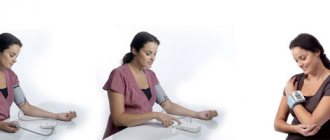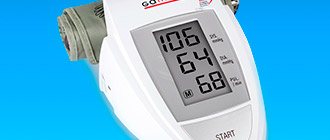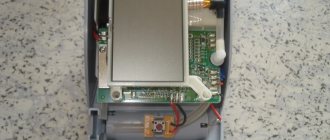Blood pressure is a kind of indicator. It shows the state of a person’s heart at the moment. It is not permissible to draw conclusions about health based only on the tonometer readings, but the readings of the device can give a signal if the heart begins to malfunction. And this means it’s time to contact a specialist. The device readings are encrypted into a special symbol system. Knowing what the numbers on a blood pressure monitor mean, you can prevent many serious conditions.
SYS and DIA numbers
Two numbers located one below the other indicate systolic and diastolic pressure. The first is measured during the ejection of blood or contraction of the heart muscle, and the second while it is relaxed. DIA (diastole) indicates the level of lower pressure, and SYS (systole) indicates the upper pressure.
Systole and diastole indicators on a tonometer
The normal rate is 135/85. Having seen such tonometer readings on the display, which mean the absence of hypertension and hypotension, you don’t have to worry about your health. For a more accurate result, it is better to take a measurement first on one hand and then on the other and calculate the arithmetic average of the two indicators.
Another significant factor is the difference between the upper and lower indicators. If the measurements show a difference much less or more than 50, then the user should report this fact to the attending physician.
A state of rest during diagnostics will help to avoid errors in the device readings. It is prohibited to speak or move until data appears on the device display.
Setting up a tonometer at home
There are several tips on how to test the mechanism for serviceability at home. There is a special installation that shows a certain pulse and breathing of a person, which it simulates. The tonometer is calibrated according to these data. But such an installation is very expensive and not everyone can afford it at home. The second way is to connect two blood pressure monitors to one cuff, one of which will be precisely adjusted by a medical equipment specialist.
A reference tonometer can be set up at a pharmacy, after which you can calibrate your equipment using this data. An accurate device is necessary in the house, because its indicators can help to draw attention to the problem in time. It is necessary to check the equipment for malfunctions, and also always ensure that the pressure is measured correctly.
Heart rate
The third digit located on the device display is the pulse. This figure is located in the bottom row under the pressure indicators.
Heart rate indicator
It is not difficult to understand what this or that number located on various models of tonometers for measuring pressure means. Heart rate depends on the age and gender of a person; on average, this indicator varies from 60 to 90 beats in 60 seconds. A rarer pulse may indicate bradycardia, a more frequent pulse may indicate tachycardia.
Conclusion
The tonometer is quite accurate and gives readings on a par with authorized (I would like to believe that they are attorneys) devices available in pharmacies and medical posts.
The price now with a coupon is OBVIOUSLY less than offline. Pros and cons
+ An automatic blood pressure monitor does not require any skills (every grandmother can figure it out) + The ability to store history for 2 users at once + a large number of records (99) + Voice acting. Plus with a caveat. An excellent option for people who are visually impaired but have basic knowledge of English numbers. - Voice acting in English only
Thank you for your attention. Health to you and your loved ones!
Arrhythmia indicator
The arrhythmia indicator is an icon located on the device display. As a rule, it is located at the very bottom of the screen, closer to the center. Depending on the make and model of the device, the appearance of the icon can vary significantly, but most often this symbol looks like a flashing heart.
Arrhythmia indicator
The icon lights up if the heart rhythm is uneven. This may indicate both the arrhythmia of the human heart and interference that arose during the measurement.
In order to exclude a random factor, you need to repeat the procedure after a few minutes. If, during three repetitions performed while the patient is at rest, an arrhythmia icon appears on the display, the user should report this fact to the therapist or cardiologist as soon as possible.
How can I check the device?
Nowadays electronic devices are the most popular because they have an affordable price. They do not require special skills from the user to measure blood pressure. Even older people, women and teenagers can cope with it. They are easy to turn on and off once the test is complete.
But measurement accuracy plays a major role. Electronic and automatic devices often malfunction. For this reason, constant checking of the tonometer is necessary to avoid mistakes.
If your friends or neighbors have another device whose accuracy has been verified, you can use it to control accuracy and settings. The second such device will help you check the accuracy of your tonometer readings and identify errors in measurements.
Some are of the opinion that it is better to carry out measurements with mechanical instruments. But modern automatic devices perform their tasks perfectly. Some of the high-quality tonometers are devices from Omron.
The parallel connection method helps to evaluate each of the two devices and check the tonometers for accuracy.
For proper verification, follow the following algorithm:
- devices are connected in parallel for simultaneous measurements;
- double testing is carried out for objective assessment, control tests;
- If necessary, check individual parts of the device.
It is incredibly important for every person to monitor their own health. This is especially acute for older people. Many people keep blood pressure monitors at home, allowing them to measure blood pressure without going to the doctor. But how to check the tonometer if there is a suspicion of inaccuracy? This article will give advice on this matter.
Graphic blood pressure level indicator
It can be difficult for an elderly person to keep a few numbers in mind and remember what normal blood pressure should be. For such people, as well as for greater clarity, many tonometer models have a graphic indicator of the blood pressure level.
Graphic blood pressure level indicator
All manufacturers position the scale differently. For some brands it is located on the body, while for others it is on the display. Figure 3 shows a tonometer with a scale placed on the body. A slider on the screen is displayed next to the danger level. The position of the slider in the green zone means that the indicator is within the normal range; if the slider is in the red zone, you should consult a therapist or cardiologist.
Appearance
The tonometer is made of white glossy plastic, it is quite durable and does not leave fingers on it. The display is normal for this type of technology, without backlight. There are only three buttons on the front side.
There is a sticker on the side with a barcode and production date. Fresh.:)
On the other side there is a compartment for batteries, it opens simply.
Powered by 2 AAA batteries
The cuff (strap) is quite thick and fits any wrist.
There is a drawing on the cuff that shows how to correctly position the device on your arm.
The cuff is fixed using the so-called “linden”
The end of the cuff, which remained free after putting the device on the arm, is bent and also fixed with “linden.” The linden is powerful and holds tightly.
The cuff is stitched
There is a speaker on the back of the case.
The device weighs 131 grams.
Device length 77.8 mm
Width 68.5 mm
Thickness at its thickest point 29.8 mm
High pressure indicator
Deviation of blood pressure readings from the norm is a serious signal that may indicate heart disease. And the treatment of such diseases must be approached without delay. That is why on the displays of some tonometer models there is an additional icon that signals high blood pressure.
Tonometer with high pressure indicator
Reference tonometer
The most effective and simple way to check the accuracy of a tonometer is to compare it with another similar device, the accuracy of which is beyond doubt.
To do this, it is necessary to measure the pressure with two instruments at once in order to avoid inaccuracies that arise over time. Next, you need to compare the performance of the two devices and take a few more measurements. Based on this, it will always be possible to understand in which direction the indicators are changing and whether they are the same.
This approach allows you to check the tonometer without much difficulty and effort, and the accuracy is quite high - you can find not only large deviations, but also record the smallest fluctuations. In addition, by visually inspecting both devices, you can find any problem in one of the components of the tonometer.
Motion indicator
On some tonometer models there is a motion indicator on the display. As a rule, it depicts a human figure.
Motion indicator
Movements while using the device can cause the device to display incorrect data, which in turn will lead to an error in diagnosis. The appearance of a motion icon on the device screen encourages the user to assume a state of rest and take the measurement again.
Device setup
You can check the tonometer for accuracy at a pharmacy. This check is carried out using a reference device. If any faults are detected at the time of purchase, you can return the device and replace it with a working one. There is also a special monitoring installation that is used to check the accuracy of the device. But it is expensive, so not everyone can afford to buy it for home setup of the device. You can also contact a workshop where it is possible to check the tonometer for accuracy and carry out repairs if necessary.
You can also connect two devices to the cuff at the same time. If one of these devices is adjusted accurately, then such a check of the tonometer is possible at home.
Indicator of correct cuff fixation
A correctly attached cuff to the forearm is half the success of obtaining accurate readings when measuring blood pressure. If you fasten the cuff looser than necessary, too tight or at the wrong level, the patient may cause pain and also delay the diagnostic process.
Example of correct cuff attachment
To avoid this factor, the display of many tonometers includes an icon for correct cuff fixation.
Indicator of correct cuff fixation
For the manufacturer OMRON, this icon looks like the abbreviation OK enclosed in a circle. The presence of an active symbol indicates correct fixation of the cuff.
What to do if you don’t have a second tonometer at hand?
If a reference tonometer that can be used for verification is not at hand, then the question of how to check a home tonometer becomes problematic. Some people try to independently count the pulse rate by ear or tap the rhythm of the heartbeat. Many people believe that they can measure their pulse on their own, without the help of a tonometer. However, this approach is fundamentally wrong - independent calculation of heart rate is inaccurate and cannot be taken into account.
If you don’t have a reference blood pressure monitor in your home, or among your neighbors or friends, you must contact a clinic, hospital, or pharmacy. There is also an option: simply call the device manufacturer’s service center and have it calibrated. Of course, this will take some time. But there are simply no other options left.
In any case, independent testing of the tonometer at home is possible only with a reference tonometer. Therefore, if there is a risk of such a situation occurring, it is better to purchase not one device, but two, using one of them as a standard.
Smart Metering Technology
If there is a heart-shaped icon on the device’s body with a curve intersecting it and the signature “Intellisense,” then the tonometer is equipped with intelligent measurement technology.
This technology provides readings during the process of pumping air into the cuff. This fact provides maximum comfort for the patient, because... eliminates the possibility of re-inflating air, as well as over-tightening the cuff. A device with Intellisense technology takes less time to measure blood pressure, and also eliminates possible painful sensations from squeezing the hand, thereby ensuring maximum accuracy of the data obtained.
Tonometer with Intellisense technology
Knowing how to decipher the tonometer readings guarantees timely diagnosis and detection of certain diseases of the circulatory system, and early diagnosis, in turn, guarantees a more successful treatment result and the prevention of painful and serious conditions.
Exploitation
Before starting work, I advise you to go into setup mode. This mode can be entered by pressing the S button for three seconds when the display is off. It immediately gives us the opportunity to select a user. An excellent opportunity to track the history of blood pressure measurements for two family members. But at the same time, you must remember to change icon 1 to 2 so that the tonometer knows who it is currently working with.
Next, click the S button and switch to the mode for changing the time and date. We change the flashing value with the M button and save it by pressing S. Correctly entered time helps to structure the entries in the history and track changes in pressure relative to the time of day. Then comes the sound on/off mode.
Then the mode selects units of measurement. mmHg and kPa.
To the left of the display is a color scale to show your blood pressure level. After the measurement, the tonometer will announce your level and display it with a dash.
Next, there is a mode for viewing the measurement history. The history contains 99 groups of records from pulse pressure time and date. The story is available for two users. When the sound is turned on, the device pronounces each recording by voice. It is possible to delete an entry. In order to enter the history mode, simply press the M button and press M again to scroll through the entries. When you select a specific entry, the time and date constantly change each other to save space on the display. After entering history mode, the M icon will appear on the top of the display
In order to finally start measuring, you need to take the desired position, sit up straight, put your hand on the table on some kind of cushion so that the tonometer is at the level of your heart, and press the button with the on/off button (bottom). If the sound is on, then the device will tell you in English that you need to sit up straight and not talk. Then it begins to draw in air, increasing the pressure in the cuff. It reaches its maximum and begins to slowly release pressure. When it senses the first pulse beats, it displays them with a “heart” icon. The cuff is inflated
If the measurement process has started, but you have not put it on your hand, the device will display an error message.
After the measurement, the tonometer will tell you your pressure and pulse, name your pressure level from “ah-yay-yay” to “it will do” and report that the measurement is completed. If you turn off the sound, the measurement will take place in complete silence.











